“A rose by any other name would smell as sweet,” Shakespeare mused, but in the floral world, it seems some flowers took the quote as a personal challenge. But how do these blooms compete with the original?
Let’s take a look at these masquerading marvels and who knows – you just might be tempted to buy and grow some of them along with roses!
Ranunculus (Ranunculus spp.)
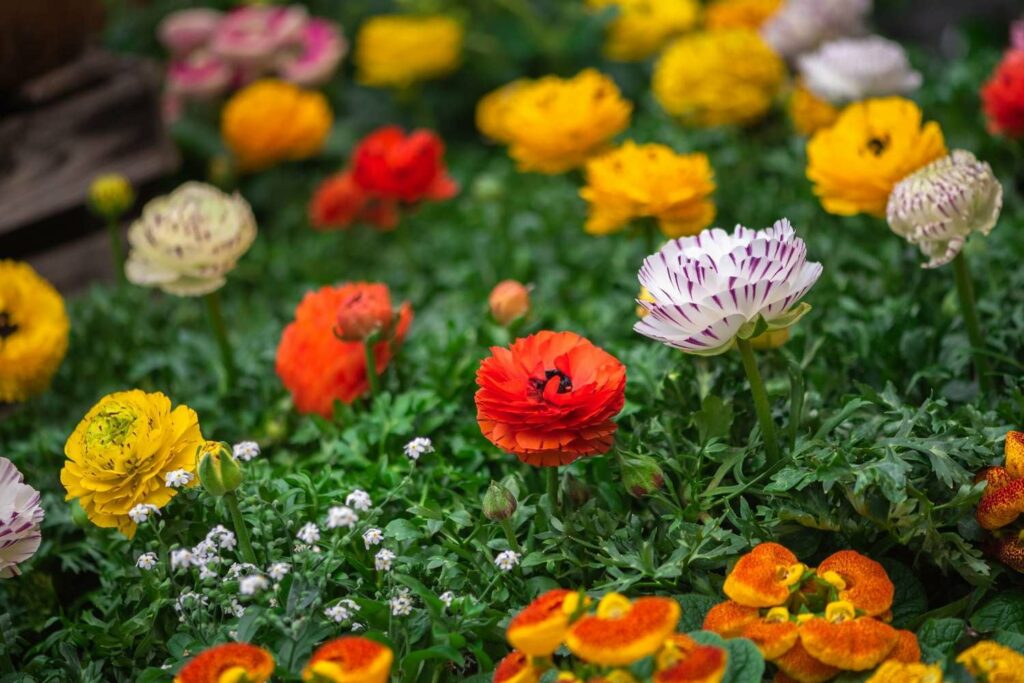
| Factor | Information |
| Ease of Growing | Moderate ●●○○○ |
| Plant Type | Perennial |
| USDA Zone | 8 to 10 |
| Blooming Season | Late winter to early summer |
| Size (Height and Width) | 6 to 12 inches (15 to 30 cm) in height, 6 to 9 inches (15 to 23 cm) in width |
| Light | Full sun to partial shade |
| Soil | Well-drained, fertile soil |
| Hardiness | Hardy in zones where winters are not severe |
| Watering | Keep soil consistently moist |
| Growth Rate | Moderate |
| Maintenance | Moderate |
Ranunculus has an Asian origin and a long history, symbolizing charm. Though not very fragrant, some types have a sweet scent and come in various colors, perfect for bouquets and other floral arrangements.
Plant them in the fall for spring blooms while ensuring good drainage and consistent watering to avoid bulb rot. Deadhead spent flowers for continuous blooming.
Peony (Paeonia spp.)
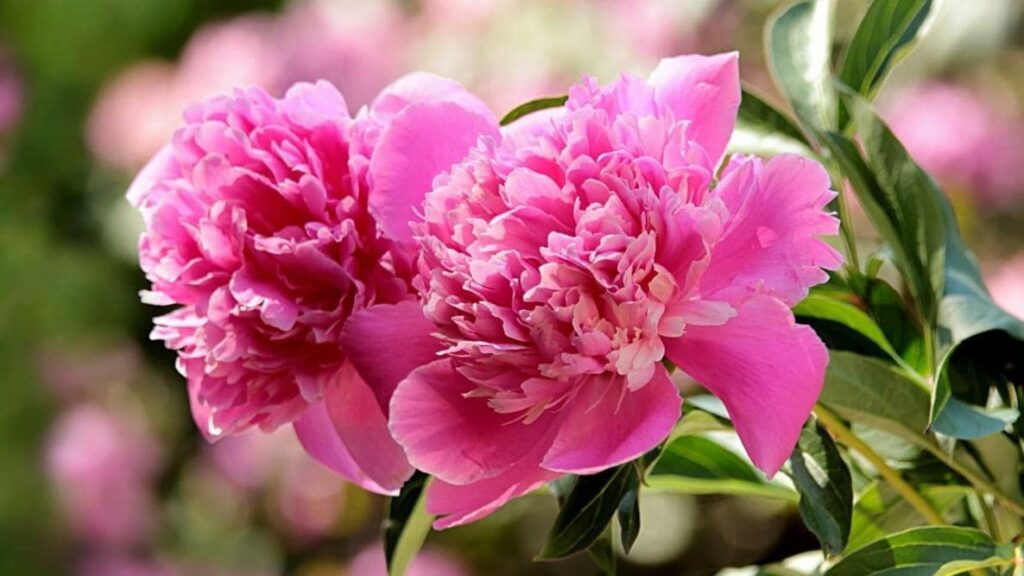
| Factor | Information |
| Ease of Growing | Easy ●○○○○ |
| Plant Type | Perennial |
| USDA Zone | 3 to 8 |
| Blooming Season | Late spring to early summer |
| Size (Height and Width) | 1.5 to 3 feet (45 to 91 cm) in height, 2 to 4 feet (61 to 122 cm) in width |
| Light | Full sun to partial shade |
| Soil | Well-drained, fertile soil |
| Hardiness | Hardy |
| Watering | Regular, deep watering |
| Growth Rate | Slow to moderate |
| Maintenance | Low |
Peonies need regular, deep watering, and they grow slowly to moderately. Despite slow growth, the reward is worth it, as they enhance gardens yearly.
Whether alone or with other plants, peonies bring elegance. To encourage blooms, remove spent flowers and support heavy ones.
Carnation (Dianthus caryophyllus)

| Factor | Information |
| Ease of Growing | Easy ●○○○○ |
| Plant Type | Perennial |
| USDA Zone | 3 to 9 |
| Blooming Season | Late spring to early summer |
| Size (Height and Width) | 12 to 24 inches (30 to 60 cm) in height, 12 to 18 inches (30 to 45 cm) in width |
| Light | Full sun |
| Soil | Well-drained, slightly alkaline soil |
| Hardiness | Hardy |
| Watering | Moderate |
| Growth Rate | Moderate |
| Maintenance | Low |
Carnations are linked with love, making them a popular choice for gifts. Some types have a sweet scent, adding to their charm.
Besides being ornamental, carnations are used in cooking for a subtle clove-like flavor. They also have traditional medicinal uses. To keep them blooming, remove spent flowers regularly.
Camellia (Camellia spp.)
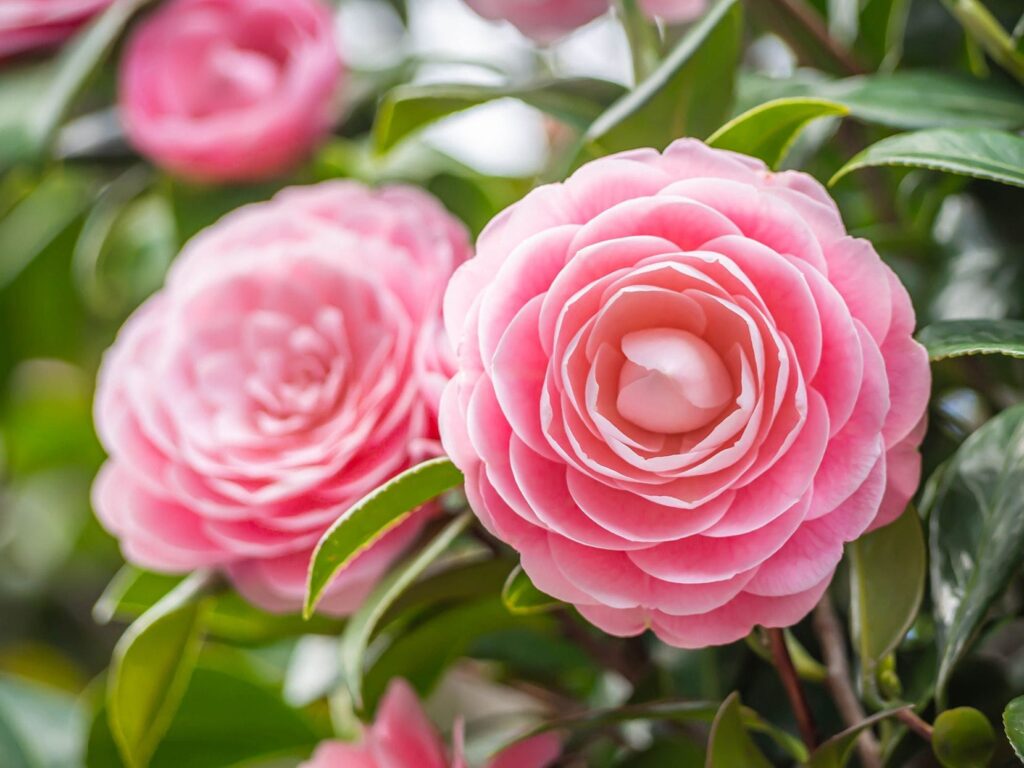
| Factor | Information |
| Ease of Growing | Moderate ●●○○○ |
| Plant Type | Evergreen shrub/tree |
| USDA Zone | 6 to 9 |
| Blooming Season | Fall to early spring |
| Size (Height and Width) | Varies by species, typically 6 to 12 feet (180 to 360 cm) in height |
| Light | Partial shade to full shade |
| Soil | Well-drained, acidic soil |
| Hardiness | Generally hardy |
| Watering | Regular |
| Growth Rate | Slow to moderate |
| Maintenance | Moderate |
Camellias, valued for centuries, come in various colors and are linked to beauty. Some types smell good while others like the Camellia sinensis gives us tea.
To keep them healthy, prune and care for them so that whether in gardens or pots, they continue to symbolize beauty and grace.
Dahlia (Dahlia spp.)
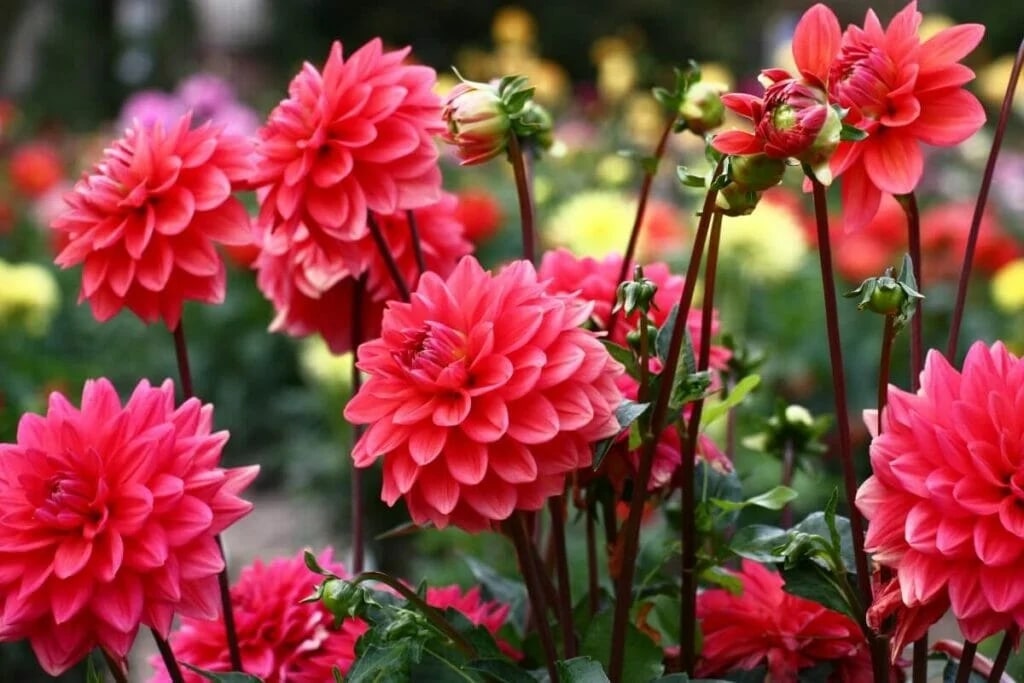
| Factor | Information |
| Ease of Growing | Moderate ●●○○○ |
| Plant Type | Tuberous perennial |
| USDA Zone | 8 to 11 |
| Blooming Season | Summer to fall |
| Size (Height and Width) | Varies by variety, typically 1 to 6 feet (30 cm to 182 cm) in height |
| Light | Full sun |
| Soil | Well-drained, fertile soil |
| Hardiness | Not frost-tolerant, lift tubers in colder climates |
| Watering | Regular |
| Growth Rate | Fast |
| Maintenance | Moderate |
Dahlias offer a variety of colors and sizes for gardens. They need regular watering, especially in dry periods, and some maintenance like deadheading and support for tall varieties.
Originating from Mexico, dahlias are now prized for ornamental purposes in gardens and competitions. Plant them in well-prepared soil, offer support, and enjoy their diverse shapes and colors in borders, containers, or as cut flowers.
Lisianthus (Eustoma spp.)

| Factor | Information |
| Ease of Growing | Moderate ●●○○○ |
| Plant Type | Annual or biennial |
| USDA Zone | 8 to 10 |
| Blooming Season | Late spring to early summer |
| Size (Height and Width) | 1 to 3 feet (30 to 91 cm) in height , 1 to 1.5 feet (30 to 45 cm) in width |
| Light | Full sun |
| Soil | Well-drained, fertile soil |
| Hardiness | Tender, treat as an annual in colder climates |
| Watering | Regular |
| Growth Rate | Moderate |
| Maintenance | Moderate |
Lisianthus blooms come in various colors, making them ideal for elegant floral arrangements. To keep them healthy, water regularly, and deadhead spent flowers.
Extend its vase life by changing water and trimming stems . Planting lisianthus in gardens adds unique beauty to landscapes, whether in borders, containers, or as cut flowers.
Begonia (Begonia spp.)
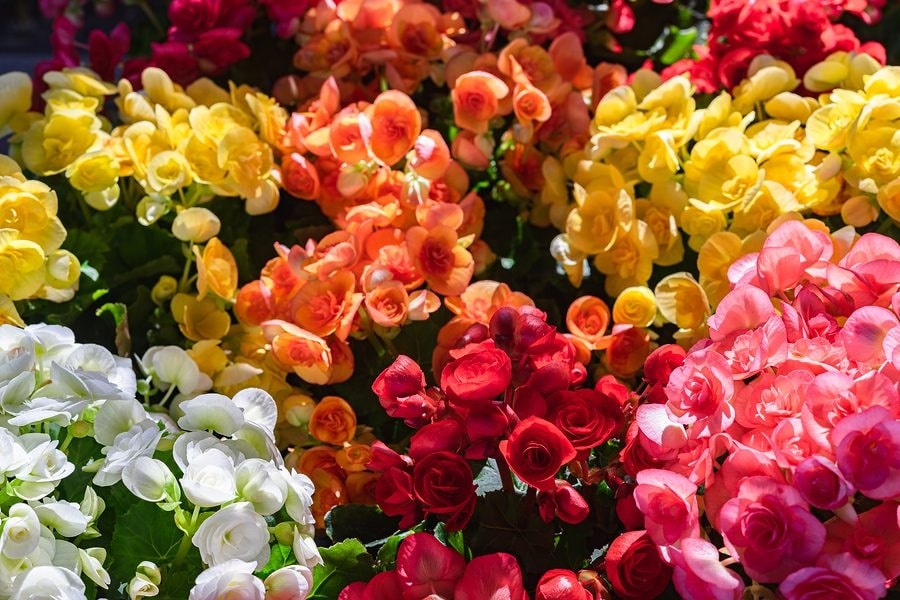
| Factor | Information |
| Ease of Growing | Easy to Moderate ●●○○○ |
| Plant Type | Annual or perennial, depending on the species |
| USDA Zone | 6 to 11 |
| Blooming Season | Spring to fall, depending on variety |
| Size (Height and Width) | Varies by species, typically 6 to 12 inches (15 to 30 cm) in height |
| Light | Partial to full shade |
| Soil | Well-drained, rich soil |
| Hardiness | Tender, treat as an annual in colder climates |
| Watering | Moderate |
| Growth Rate | Moderate |
| Maintenance | Low to moderate |
Begonias have diverse leaf colors and patterns, and some types produce small flowers in pink, red, or white. Begonias thrive in shade, making them ideal for shaded gardens or indoor plants.
They require low to moderate maintenance, including deadheading flowers and removing damaged leaves. Begonias are suitable for all gardeners, offering options for visually appealing landscapes.
Double Impatiens (Impatiens walleriana)
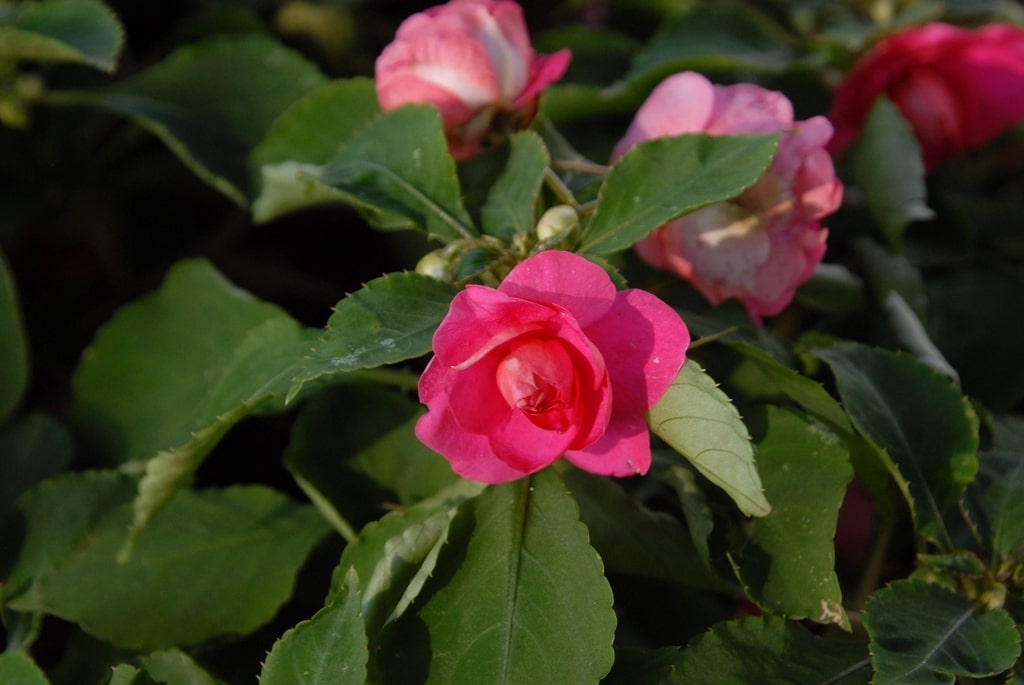
| Factor | Information |
| Ease of Growing | Easy ●○○○○ |
| Plant Type | Annual |
| USDA Zone | 10 to 11 |
| Blooming Season | Late spring to fall |
| Size (Height and Width) | 8 to 24 inches (20 to 60 cm) in height, 12 to 24 inches (20 to 60 cm) in width |
| Light | Partial to full shade |
| Soil | Moist, well-drained soil |
| Hardiness | Tender, treat as an annual in colder climates |
| Watering | Regular |
| Growth Rate | Fast |
| Maintenance | Low |
Double Impatiens come in various colors like pink, purple, red, and white. They prefer moist, well-drained soil and need regular watering as they grow fast and fill spaces with foliage and blooms, creating an attractive garden display.
While not frost-tolerant, they’re often treated as annuals in colder climates. They may need occasional deadheading for continuous blooming and shape maintenance.
Double Tulip (Tulipa spp.)

| Factor | Information |
| Ease of Growing | Easy ●○○○○ |
| Plant Type | Perennial |
| USDA Zone | 3 to 8 |
| Blooming Season | Spring |
| Size (Height and Width) | Varies by variety, typically 12 to 24 inches (30 to 60 cm) in height |
| Light | Full sun |
| Soil | Well-drained soil |
| Hardiness | Hardy |
| Watering | Moderate |
| Growth Rate | Moderate |
| Maintenance | Low |
Double Tulips return each spring with charming blossoms, needing little care. They come in various colors, perfect for flower beds, borders, or containers.
Water moderately and let the foliage wither after spring for healthy bulbs the next year.
Gardenia (Gardenia spp.)
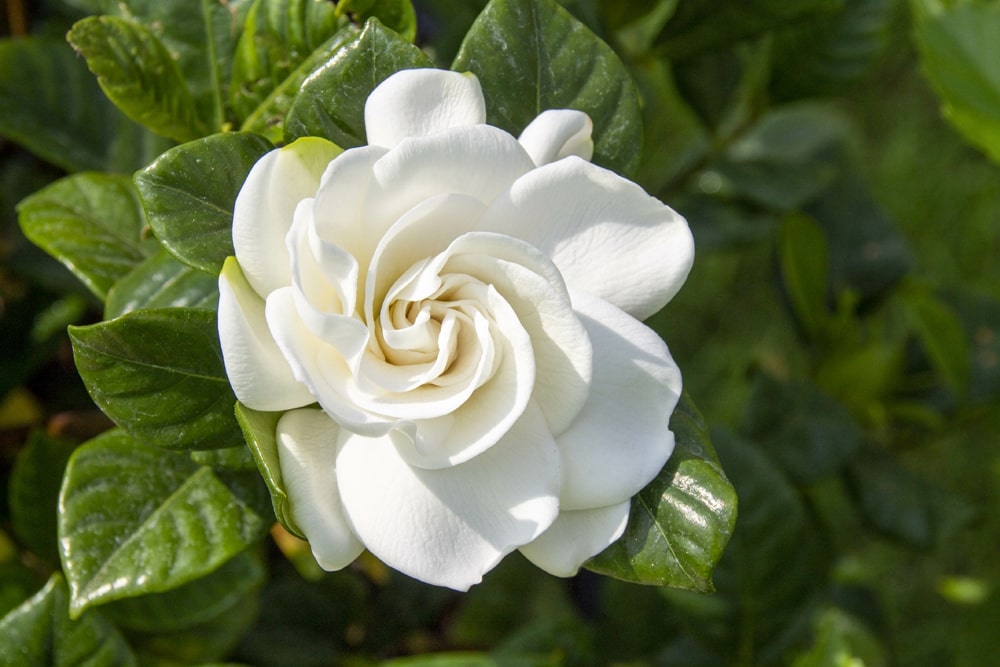
| Factor | Information |
| Ease of Growing | Moderate ●●○○○ |
| Plant Type | Evergreen shrub |
| USDA Zone | 8 to 11 |
| Blooming Season | Late spring to early summer |
| Size (Height and Width) | 2 to 8 feet (60 to 240 cm) in height, 2 to 6 feet (60 to 180 cm) in width |
| Light | Partial shade to full sun |
| Soil | Well-drained, acidic soil |
| Hardiness | Frost-tender, protect in colder climates |
| Watering | Regular |
| Growth Rate | Slow to moderate |
| Maintenance | Moderate |
Gardenias grow slowly to moderately, looking compact and bushy. They need some care, but the effort pays off with lovely blooms and a delightful fragrance.
Besides being ornamental, they’re used in perfumes, corsages, and bouquets. To keep them healthy, meet their needs for soil acidity, moisture, and winter protection.
Double Anemone (Anemone coronaria)
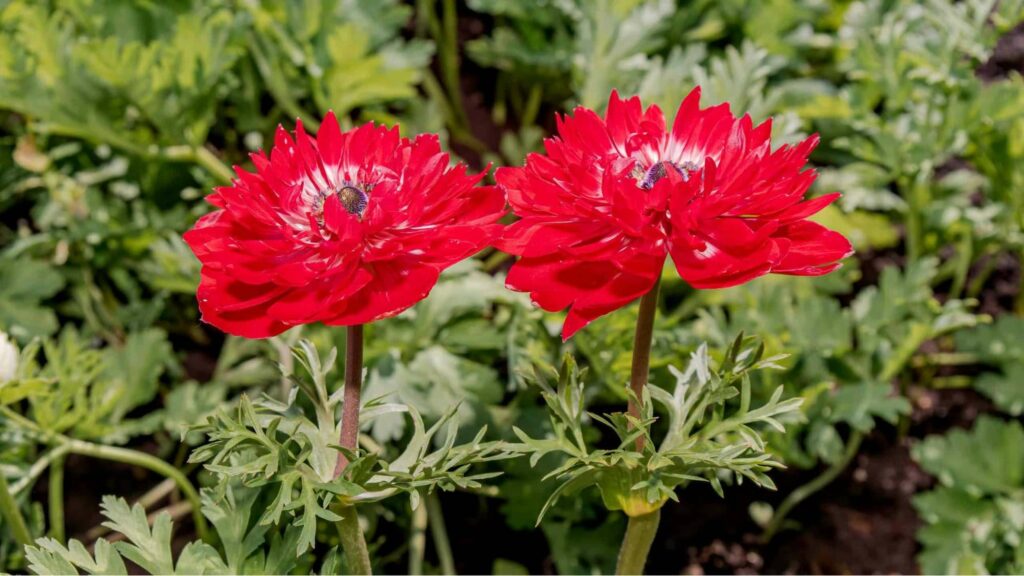
| Factor | Information |
| Ease of Growing | Moderate ●●○○○ |
| Plant Type | Perennial |
| USDA Zone | 6 to 10 |
| Blooming Season | Late spring to early summer |
| Size (Height and Width) | 12 to 18 inches (30 to 46 cm) in height, 9 to 12 inches (23 to 30 cm) in width |
| Light | Full sun |
| Soil | Well-drained, fertile soil |
| Hardiness | Hardy |
| Watering | Regular |
| Growth Rate | Moderate |
| Maintenance | Low |
Double Anemones are tough and thrive with regular watering. Their lobed foliage adds interest even when not in bloom.
They come in red, pink, purple, and white, perfect for diverse garden displays. With an old-fashioned charm, they suit cottage gardens and require low maintenance.
Double Dianthus (Dianthus spp.)
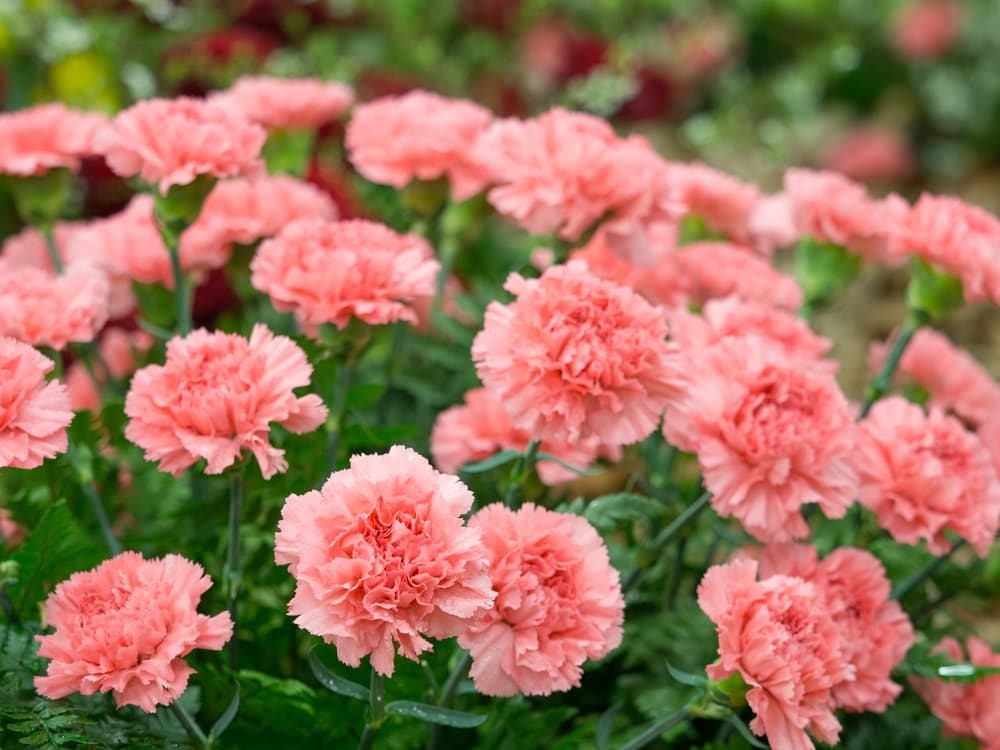
| Factor | Information |
| Ease of Growing | Easy to Moderate ●●○○○ |
| Plant Type | Perennial |
| USDA Zone | 3 to 9 |
| Blooming Season | Late spring to early summer |
| Size (Height and Width) | 6 to 12 inches (15 to 30 cm) in height, 6 to 9 inches (15 to 23 cm) in width |
| Light | Full sun |
| Soil | Well-drained, slightly alkaline soil |
| Hardiness | Hardy |
| Watering | Moderate |
| Growth Rate | Moderate |
| Maintenance | Low to moderate |
Double Dianthus flowers come in pink, red, white, and bicolors, and their compact size makes them great for borders, rock gardens, or containers. Keep the soil consistently moist with regular watering for healthy growth and vibrant blooms.
With low maintenance, they add texture and color to gardens, and deadheading encourages continuous blooming. The fragrant blossoms are perfect for cut flower arrangements.
Double Petaled Jasmine (Jasminum spp.)
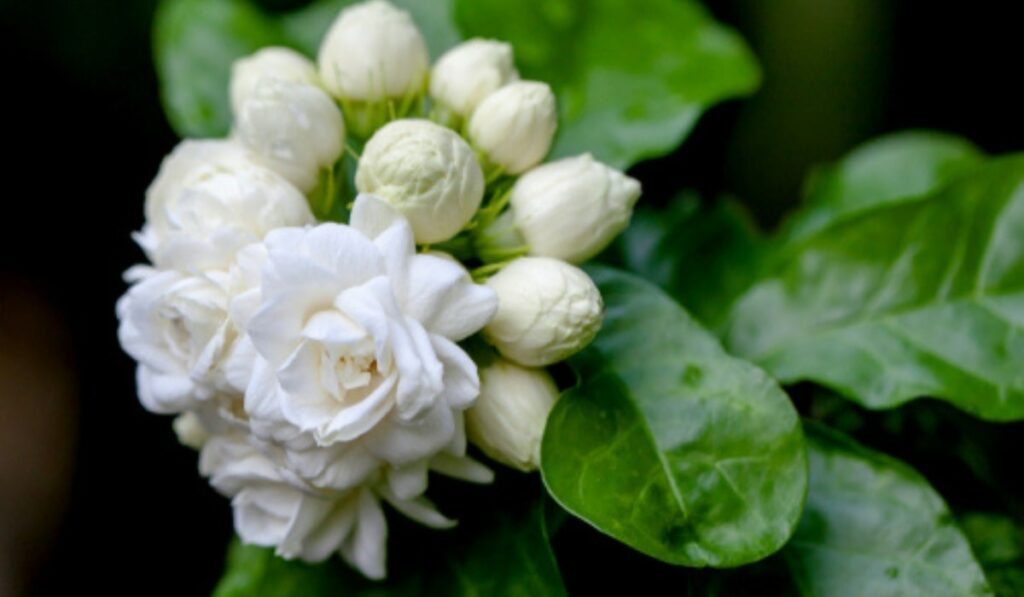
| Factor | Information |
| Ease of Growing | Easy ●○○○○ |
| Plant Type | Perennial |
| USDA Zone | 7 to 10 |
| Blooming Season | Spring to fall |
| Size (Height and Width) | Varies by species, typically 6 to 10 feet (183 to 305 cm) in height |
| Light | Full sun to partial shade |
| Soil | Well-drained, fertile soil |
| Hardiness | Generally hardy |
| Watering | Regular |
| Growth Rate | Fast |
| Maintenance | Low to moderate |
Double Petaled Jasmine flowers bring elegance and fragrance to gardens. With low to moderate maintenance, it’s suitable for all gardeners.
Pruning helps maintain a neat look and encourages healthy blooms. Whether standalone or in a fragrant garden, Double Petaled Jasmine adds beauty and aroma to outdoor spaces.
Japanese Rose (Kerria japonica)
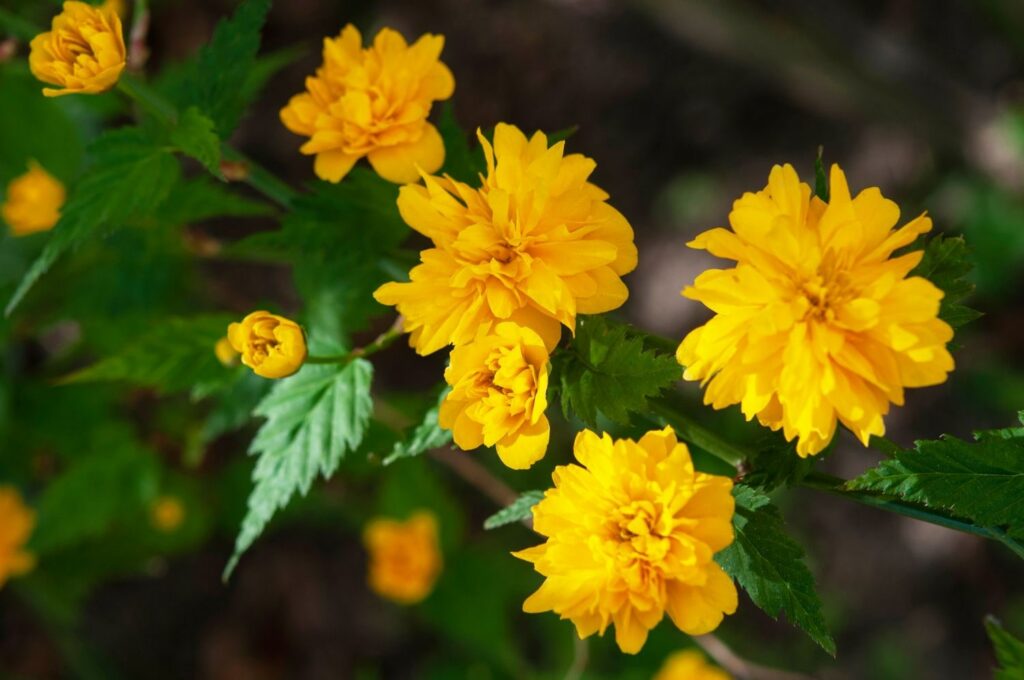
| Factor | Information |
| Ease of Growing | Easy to Moderate ●●○○○ |
| Plant Type | Deciduous shrub |
| USDA Zone | 4 to 9 |
| Blooming Season | Spring to early summer |
| Size (Height and Width) | 3 to 6 feet (91 to 183 cm) in height, 4 to 9 feet (122 to 274 cm) in width |
| Light | Partial shade to full sun |
| Soil | Well-drained, moist soil |
| Hardiness | Hardy |
| Watering | Moderate |
| Growth Rate | Moderate |
| Maintenance | Low to moderate |
Japanese Rose blooms in spring with vibrant double-petaled yellow flowers, perfect for borders or standalone use. It has low maintenance, and pruning shapes the shrub for a tidy look.
Ideal for adding vibrancy to gardens, Japanese Rose suits various garden designs.
Moss Rose (Portulaca grandiflora)
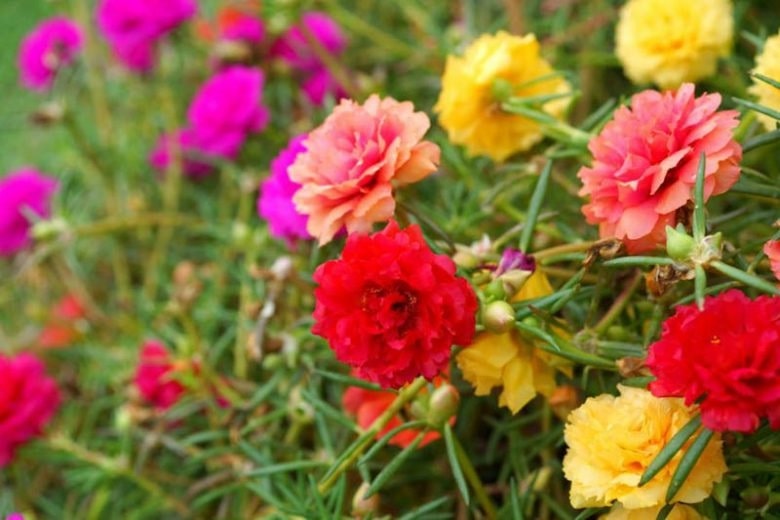
| Factor | Information |
| Ease of Growing | Easy ●○○○○ |
| Plant Type | Annual |
| USDA Zone | 2 to 11 |
| Blooming Season | Late spring to fall |
| Size (Height and Width) | 6 to 8 (15 to 20 cm) inches in height, spreading up to 14 inches (35 cm) |
| Light | Full sun |
| Soil | Well-drained, sandy soil |
| Hardiness | Frost-tender, treat as an annual in colder climates |
| Watering | Low to moderate |
| Growth Rate | Fast |
| Maintenance | Low |
Moss Rose is a fast-growing plant known for its colorful blooms, including pink, red, orange, yellow, and white. It’s often treated as an annual in colder climates due to its frost-tender nature.
With succulent-like stems, it quickly covers the ground, making it a versatile and low-maintenance choice for borders, rock gardens, or hanging baskets. Moss Rose is resilient, thriving in hot and dry conditions.
Persian Buttercup (Ranunculus asiaticus)
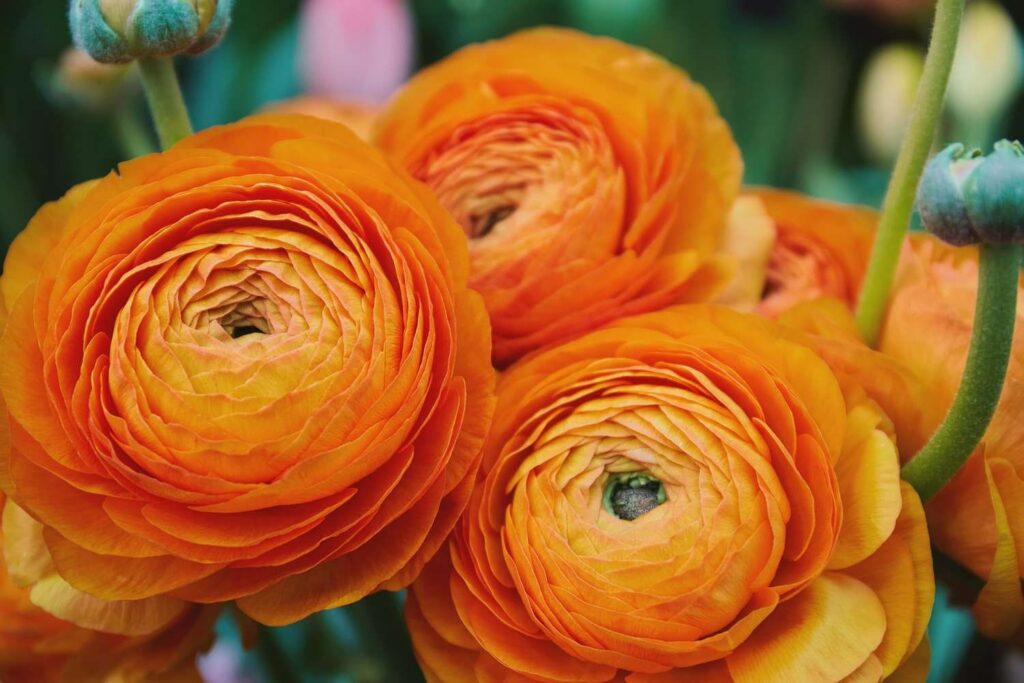
| Factor | Information |
| Ease of Growing | Moderate ●●○○○ |
| Plant Type | Perennial |
| USDA Zone | 8 to 10 |
| Blooming Season | Spring |
| Size (Height and Width) | 12 to 18 inches (30 to 46 cm) in height, 9 to 12 inches (23 to 30 cm) in width |
| Light | Full sun |
| Soil | Well-drained, fertile soil |
| Hardiness | Hardy |
| Watering | Regular |
| Growth Rate | Moderate |
| Maintenance | Moderate |
Persian Buttercup, with colorful flowers resembling roses, adds beauty to gardens and bouquets. It needs moderate care, so just deadhead spent flowers, water well, and provide nutrients for prolonged blooming.
Planted or cut, it enhances gardens with vibrant colors and elegance.
Solenia ‘Dusty Rose’ Begonia (Begonia × tuberhybrida)
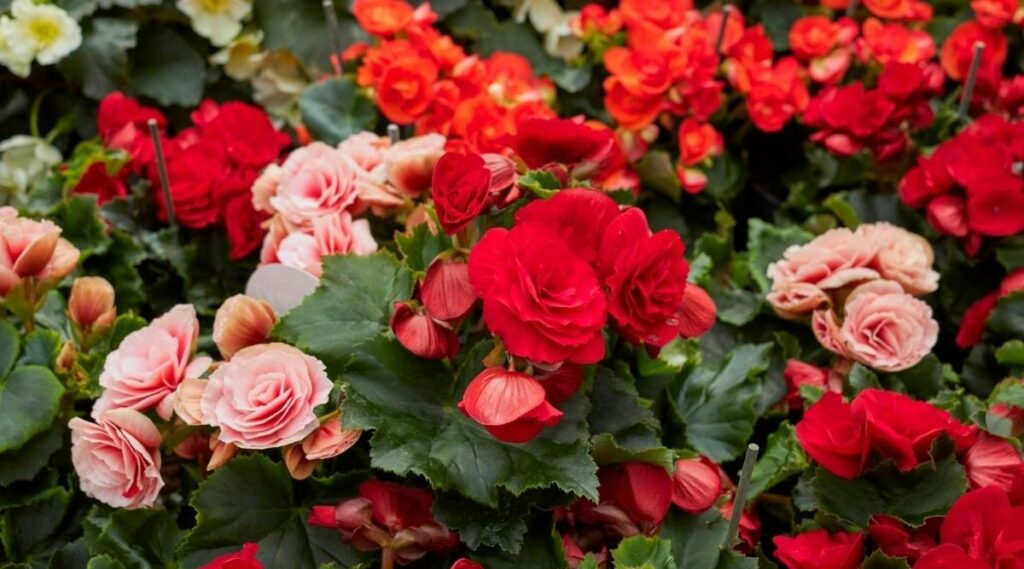
| Factor | Information |
| Ease of Growing | Easy to Moderate ●●○○○ |
| Plant Type | Annual |
| USDA Zone | 9-11 |
| Blooming Season | Spring to fall |
| Size (Height and Width) | 12 to 18 inches (30 to 46 cm) in height, 12 to 15 inches (30 to 38 cm) in width |
| Light | Partial shade to full shade |
| Soil | Well-drained, fertile soil |
| Hardiness | Tender, treat as an annual |
| Watering | Moderate |
| Growth Rate | Moderate |
| Maintenance | Low to moderate |
The ‘Dusty Rose’ begonia has soft pink flowers, bringing elegance to gardens. It’s great for shaded areas, hanging baskets, or containers.
Low-maintenance and visually appealing, it’s reliable in terms of flowering. Deadhead and care for prolonged blooming, making it perfect for borders or containers.
Cotton Rose Hibiscus (Hibiscus mutabilis)
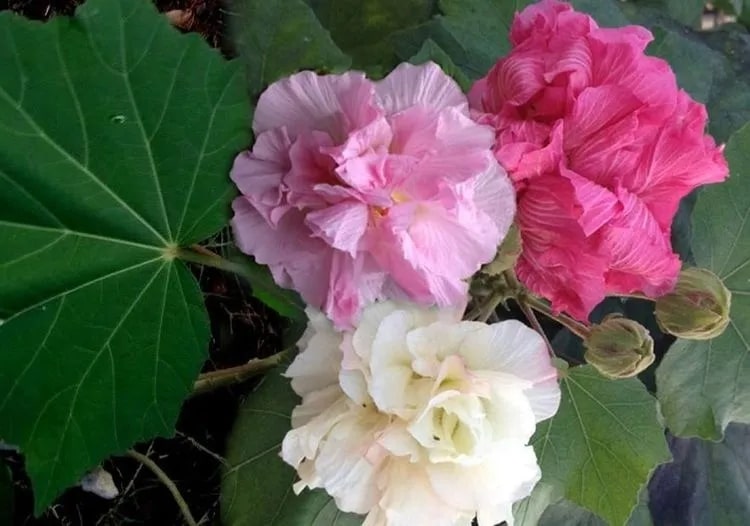
| Factor | Information |
| Ease of Growing | Easy to Moderate ●●○○○ |
| Plant Type | Perennial shrub |
| USDA Zone | 9 to 11 |
| Blooming Season | Spring to fall, intermittent blooming |
| Size (Height and Width) | 6 to 10 feet (183-305 cm) in height, 4 to 6 feet (122 to 183 cm) in width |
| Light | Full sun |
| Soil | Well-drained, fertile soil |
| Hardiness | Frost-tender, protect in colder climates |
| Watering | Regular |
| Growth Rate | Moderate |
| Maintenance | Low to moderate |
Cotton Rose Hibiscus produces large, changing-color flowers. Protect it from frost, water regularly for healthy growth, and enjoy its rose-like flowers that shift from white to pink to deep red.
With moderate growth, occasional pruning keeps it in shape. Cotton Rose Hibiscus adds vibrant blooms and tropical charm to gardens with low to moderate maintenance.
Oriental Poppies (Papaver orientale)
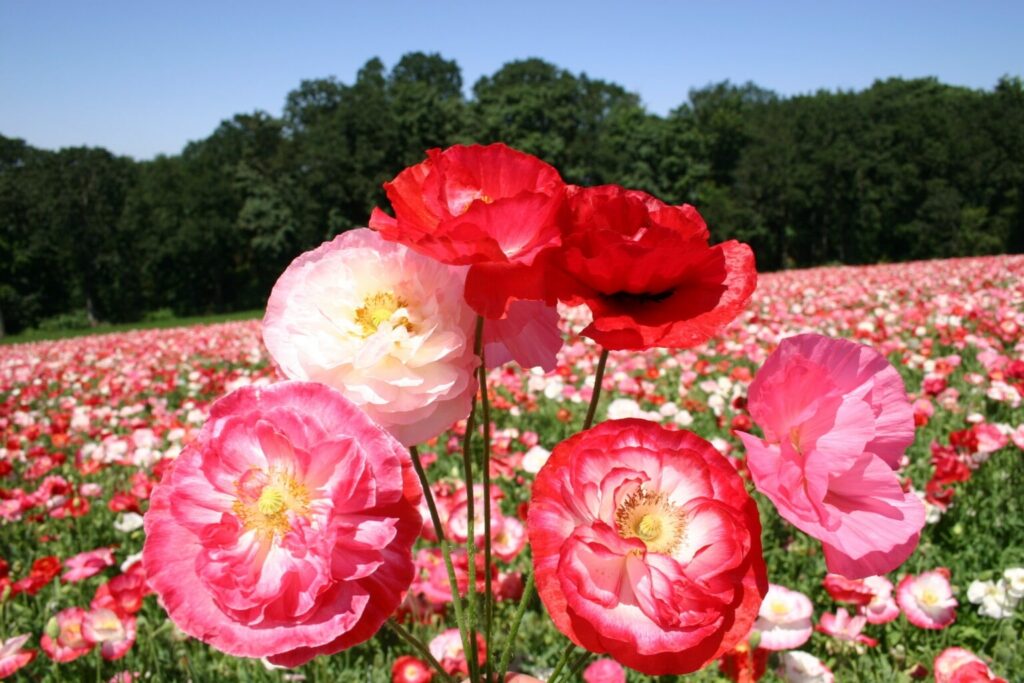
| Factor | Information |
| Ease of Growing | Easy ●○○○○ |
| Plant Type | Perennial |
| USDA Zone | 3 to 7 |
| Blooming Season | Late spring to early summer |
| Size (Height and Width) | 24 to 36 inches (61 to 91 cm) in height, 18 to 24 ()46 to 61 cm) inches in width |
| Light | Full sun |
| Soil | Well-drained, fertile soil |
| Hardiness | Hardy |
| Watering | Moderate |
| Growth Rate | Moderate |
| Maintenance | Low |
Oriental Poppies are hardy and grow moderately, producing vibrant, thin-petaled flowers. Keep the soil consistently moist by watering regularly, especially during dry periods.
The blooms come in various shades, adding color to gardens as borders or as standalone plants. Deadhead to encourage more blooms, and minimal pruning keeps them tidy.
Double Bloom Million Bells (Calibrachoa)
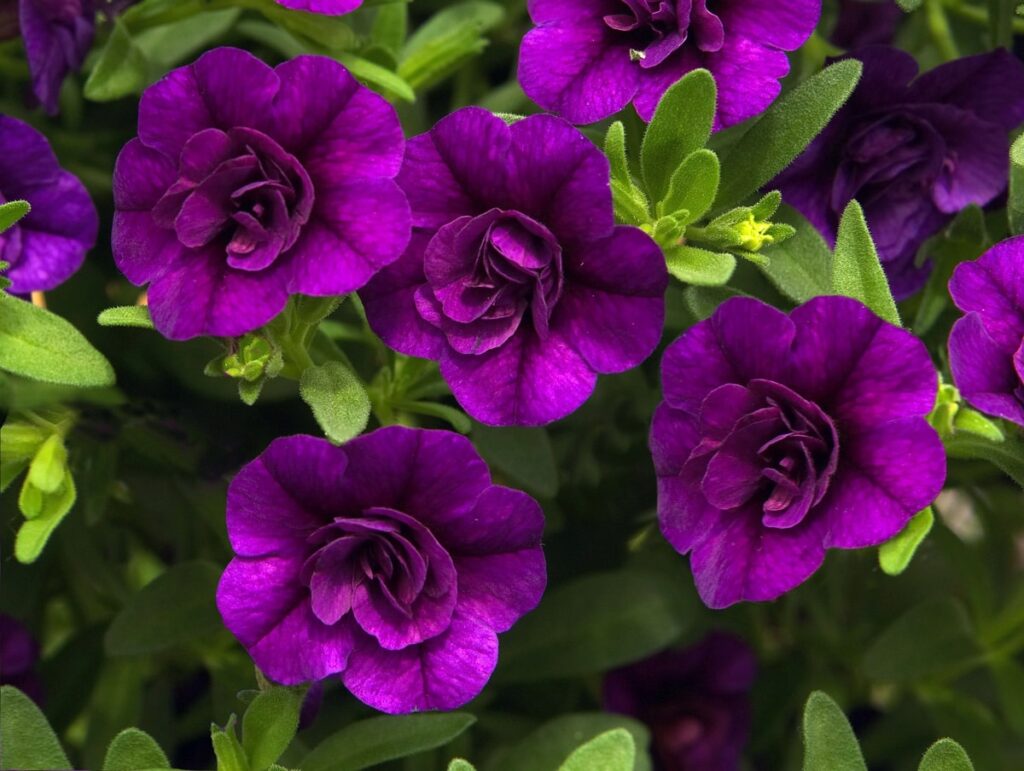
| Factor | Information |
| Ease of Growing | Easy to Moderate ●●○○○ |
| Plant Type | Annual |
| USDA Zone | 9 to 11 |
| Blooming Season | Spring to fall |
| Size (Height and Width) | 6 to 10 inches (15 to 25 cm) in height, trailing habit |
| Light | Full sun |
| Soil | Well-drained, fertile soil |
| Hardiness | Frost-tender, treat as an annual |
| Watering | Regular |
| Growth Rate | Fast |
| Maintenance | Low to moderate |
Double Bloom Million Bells are treated as annuals in colder climates due to their sensitivity to frost. They grow fast, covering containers or hanging baskets with double flowers.
These flowers come in various colors, adding vibrancy to gardens. With a compact size, they suit hanging baskets, containers, and borders.
Double Bloom Azalea (Rhododendron spp.)
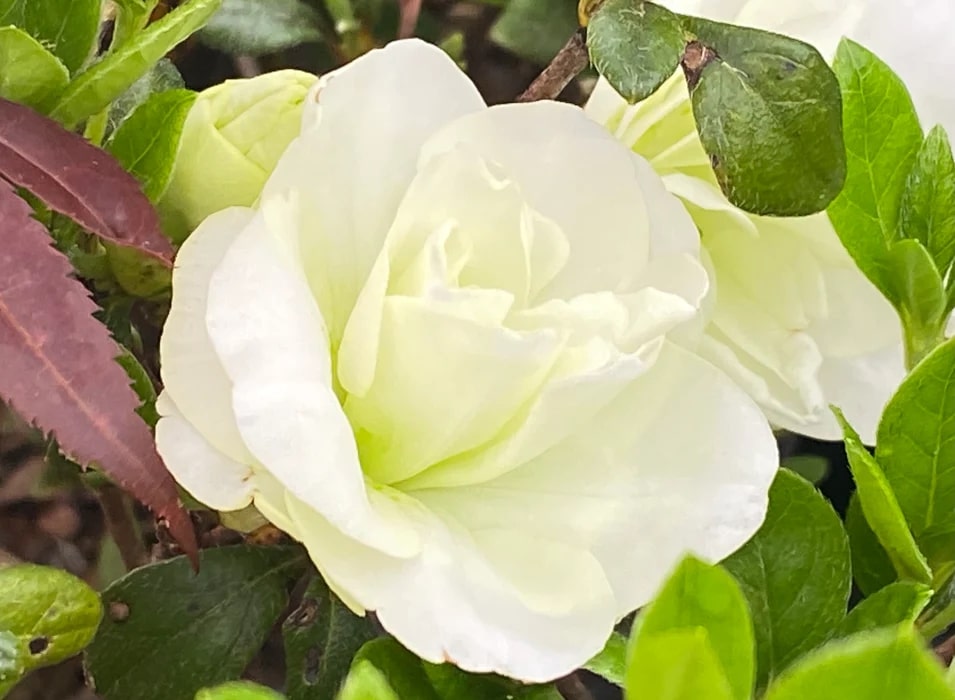
| Factor | Information |
| Ease of Growing | Moderate ●●○○○ |
| Plant Type | Shrub |
| USDA Zone | 4 to 9 |
| Blooming Season | Spring to early summer |
| Size (Height and Width) | Varies by species, typically 3 to 8 feet (91 to 244 cm) in height |
| Light | Partial shade to full sun |
| Soil | Well-drained, acidic soil |
| Hardiness | Varies by species, generally hardy |
| Watering | Regular |
| Growth Rate | Slow to moderate |
| Maintenance | Moderate |
Azaleas vary in hardiness, generally doing well. Azaleas come in various colors, like pink, red, purple, white, and orange, with a compact, bushy look due to their slow to moderate growth.
They need occasional pruning for shaping and removing dead branches. Mulching with organic matter helps maintain soil acidity and moisture.





